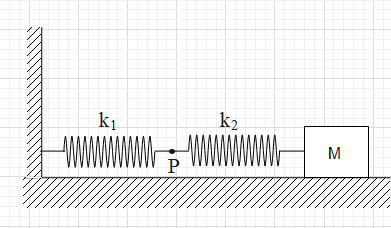Question
Question: The mass M shown in the figure oscillates in simple harmonic motion with amplitude A. The amplitude ...
The mass M shown in the figure oscillates in simple harmonic motion with amplitude A. The amplitude of the point P is

A. k2k1A
B. k1k2A
C. k1+k2k1A
D. k1+k2k2A
Solution
When the block oscillates, the springs will elongate in such a way that the force exerted by both is the same. Use the formula for the spring force and an expression for the extension in the left spring when the block is at the right extreme. This value will be the amplitude of point P.
Formula used:
F=-kx
Complete answer:
As we can see in the given figure, a block of mass M is attached to a combination of two springs. The springs are connected in series. It is said that the block is under simple harmonic motion with an amplitude A.
When the block is at its right extreme, the displacement of the block from the mean position is A. Let the extensions in the springs with spring constants k1 and k2 be x1 and x2 respectively.
Here, x1+x2=A.
When the block oscillates, the springs will elongate in such a way that the force exerted by both is the same.
That means that F=k1x1=k2x2.
⇒x1=k1F
And
x2=k2F
But x1+x2=A.
⇒k1F+k2F=A
⇒F(k11+k21)=A
⇒F=(k11+k21)A=k1+k2Ak1k2 …. (i).
Since the one end of the left spring is fixed, the amplitude of point P is equal to x1.
And we know that x1=k1F
Substitute the value of F from (i).
⇒x1=k1k1+k2Ak1k2
⇒x1=k1+k2k2A
So, the correct answer is “Option D”.
Note:
When we have a combination of spring, we define the equivalent spring constant of the combination. Let the equivalent spring constant of the combination be keq.
When the total extension is equal to A, F=keqA
And we found that ⇒F=(k11+k21)A.
This implies that keq=(k11+k21)1
⇒keq1=k11+k21.
